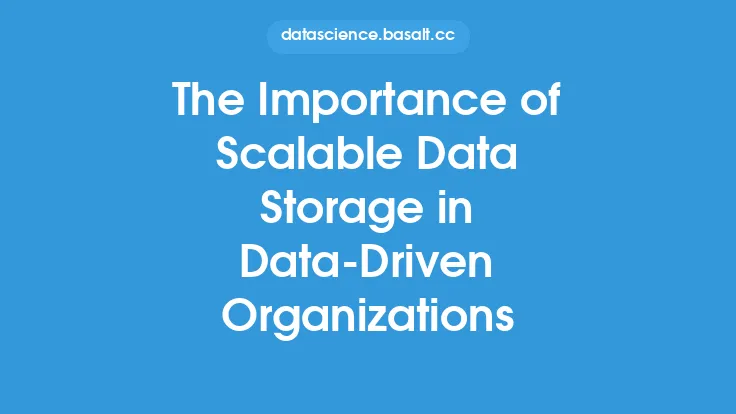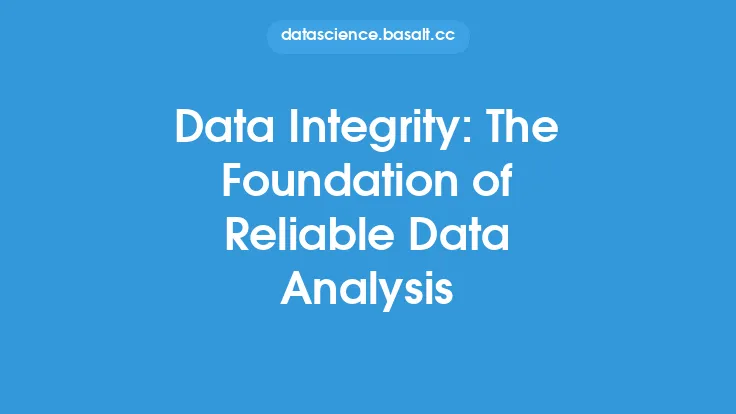Data consistency is the backbone of any data-driven organization, as it ensures that the data used for analysis and decision-making is accurate, reliable, and trustworthy. In today's digital age, where data is generated at an unprecedented rate, maintaining data consistency is more crucial than ever. Inconsistent data can lead to incorrect insights, poor decision-making, and ultimately, negative business outcomes. In this article, we will delve into the world of data consistency, exploring its definition, importance, and key concepts, as well as the technical aspects of achieving and maintaining data consistency.
Introduction to Data Consistency
Data consistency refers to the degree to which data values are consistent with the rules, constraints, and semantics defined for the data. It involves ensuring that data is accurate, complete, and consistent across different systems, applications, and datasets. Data consistency is not just about ensuring that data is free from errors, but also about ensuring that it is consistent in terms of format, syntax, and semantics. For instance, a date field should always be in the format "YYYY-MM-DD", and a phone number field should always be in the format "(123) 456-7890". Consistent data enables organizations to make informed decisions, identify trends and patterns, and optimize business processes.
Key Concepts in Data Consistency
There are several key concepts that are essential to understanding data consistency. These include:
- Data integrity: Refers to the accuracy and completeness of data, ensuring that it is not corrupted or altered during storage or transmission.
- Data validation: Involves checking data against a set of rules or constraints to ensure that it is consistent and accurate.
- Data normalization: The process of organizing data in a way that minimizes data redundancy and dependency, ensuring that each piece of data is stored in one place and one place only.
- Data standardization: Involves converting data into a standard format, ensuring that it is consistent across different systems and applications.
- Data quality metrics: These are used to measure the consistency and accuracy of data, providing insights into data quality and identifying areas for improvement.
Technical Aspects of Data Consistency
Achieving and maintaining data consistency requires a combination of technical and non-technical strategies. From a technical perspective, data consistency can be achieved through the use of:
- Database constraints: These are rules that are defined at the database level to ensure data consistency, such as primary keys, foreign keys, and check constraints.
- Data validation rules: These are rules that are defined at the application level to ensure data consistency, such as format checks and range checks.
- Data transformation and mapping: These involve converting data from one format to another, ensuring that it is consistent and accurate.
- Data quality tools: These are software applications that are designed to monitor and improve data quality, providing insights into data consistency and accuracy.
- Data governance frameworks: These are frameworks that define policies, procedures, and standards for data management, ensuring that data is consistent and accurate across the organization.
Benefits of Data Consistency
The benefits of data consistency are numerous and well-documented. These include:
- Improved decision-making: Consistent data enables organizations to make informed decisions, reducing the risk of incorrect insights and poor decision-making.
- Increased efficiency: Consistent data reduces the need for manual data correction and validation, freeing up resources for more strategic activities.
- Enhanced customer experience: Consistent data enables organizations to provide a more personalized and seamless customer experience, improving customer satisfaction and loyalty.
- Better compliance: Consistent data enables organizations to comply with regulatory requirements, reducing the risk of non-compliance and associated penalties.
- Improved data analytics: Consistent data enables organizations to perform more accurate and reliable data analytics, providing insights into business trends and patterns.
Challenges in Achieving Data Consistency
Despite the importance of data consistency, achieving and maintaining it can be challenging. Some of the common challenges include:
- Data silos: These are isolated datasets that are not integrated with other datasets, making it difficult to achieve data consistency.
- Data complexity: Large and complex datasets can be difficult to manage, making it challenging to achieve data consistency.
- Lack of standardization: Inconsistent data formats and standards can make it difficult to achieve data consistency.
- Insufficient data governance: Weak data governance frameworks can make it difficult to achieve data consistency, as there may be no clear policies or procedures for data management.
- Limited resources: Achieving and maintaining data consistency can require significant resources, including time, money, and personnel.
Best Practices for Achieving Data Consistency
To achieve and maintain data consistency, organizations should follow best practices such as:
- Developing a data governance framework: This should define policies, procedures, and standards for data management, ensuring that data is consistent and accurate across the organization.
- Implementing data validation and quality checks: These should be implemented at the point of data entry, ensuring that data is accurate and consistent from the outset.
- Using data standardization and normalization techniques: These should be used to convert data into a standard format, ensuring that it is consistent across different systems and applications.
- Providing training and awareness programs: These should be provided to personnel, ensuring that they understand the importance of data consistency and how to achieve it.
- Monitoring and measuring data quality: This should be done on a regular basis, providing insights into data consistency and accuracy, and identifying areas for improvement.





